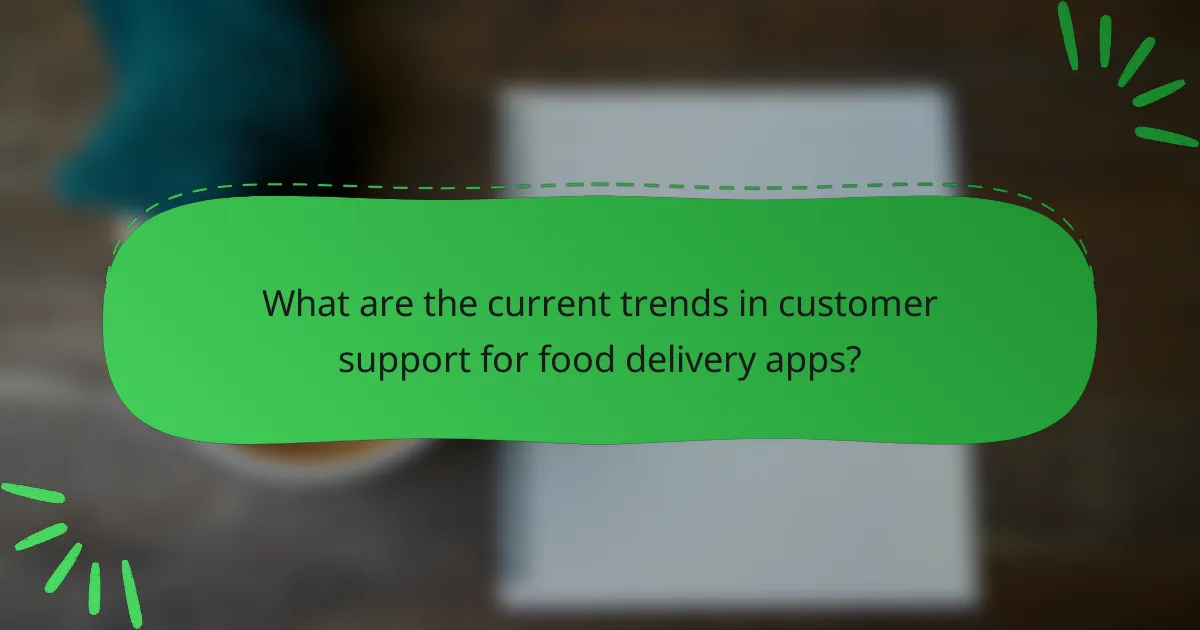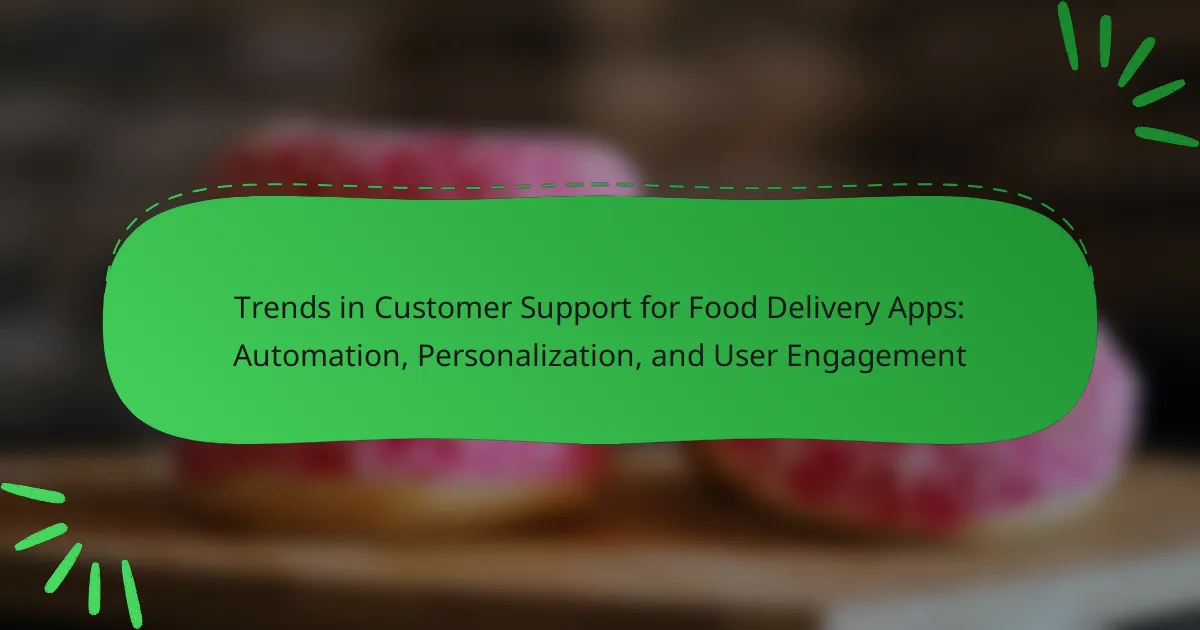The article focuses on current trends in customer support for food delivery applications, highlighting the roles of automation, personalization, and user engagement. Automation is primarily facilitated through chatbots and AI, streamlining responses to common inquiries and allowing human agents to manage more complex issues. Personalization involves customizing interactions based on individual user preferences and order histories, enhancing the overall customer experience. Additionally, improved user engagement is achieved through proactive communication strategies, such as providing order updates and soliciting feedback. These trends indicate a significant shift towards more efficient and customer-centric support models within the food delivery sector.

What are the current trends in customer support for food delivery apps?
Current trends in customer support for food delivery apps include increased automation, enhanced personalization, and improved user engagement. Automation is being leveraged through chatbots and AI to handle common inquiries efficiently. This reduces response times and allows human agents to focus on complex issues. Personalization is achieved by tailoring interactions based on user preferences and order history. This approach fosters a more engaging customer experience. User engagement is being enhanced through proactive communication, such as order updates and feedback requests. These trends reflect a shift towards more efficient and customer-centric support models in the food delivery industry.
How is automation transforming customer support in food delivery apps?
Automation is transforming customer support in food delivery apps by enhancing response times and streamlining operations. Automated systems handle inquiries through chatbots, allowing 24/7 support. This reduces wait times significantly, improving user satisfaction. Additionally, automation enables order tracking updates without human intervention. It also personalizes customer interactions based on previous orders and preferences. Data analytics within automation helps identify common issues, allowing for proactive solutions. According to a report by McKinsey, companies using automation in customer service can reduce operational costs by 30%. Overall, automation increases efficiency and enhances the customer experience in food delivery apps.
What technologies are driving automation in customer support?
Artificial intelligence (AI) and machine learning are key technologies driving automation in customer support. AI chatbots handle customer inquiries efficiently. They provide instant responses, reducing wait times. Machine learning algorithms analyze customer data for personalized experiences. Natural language processing (NLP) enables chatbots to understand and respond to human language. Automation tools streamline ticketing systems, ensuring issues are tracked and resolved quickly. Cloud-based platforms facilitate scalability in customer support operations. These technologies enhance overall customer satisfaction and operational efficiency.
How does automation improve response times and efficiency?
Automation significantly improves response times and efficiency in customer support for food delivery apps. It allows for instant processing of inquiries and requests. Automated systems can handle multiple queries simultaneously. This reduces the wait time for customers. Automation also minimizes human error in responses. According to a study by McKinsey, companies that implement automation can see productivity gains of up to 30%. Additionally, automated chatbots provide 24/7 support, ensuring assistance is available at all times. This leads to higher customer satisfaction and retention rates.
What role does personalization play in customer support for food delivery apps?
Personalization enhances customer support in food delivery apps by tailoring interactions to individual user preferences. This approach improves user satisfaction and fosters loyalty. Personalized support can include addressing users by name and remembering past orders. It allows for proactive communication regarding order status and potential issues. According to a study by Salesforce, 70% of consumers expect personalized experiences from brands. Effective personalization can lead to quicker resolution times and increased customer retention rates. Food delivery apps that implement personalized support often see higher engagement levels.
How can personalized experiences enhance customer satisfaction?
Personalized experiences enhance customer satisfaction by tailoring services to individual preferences. This approach creates a sense of recognition and value among customers. When users receive recommendations based on their order history, they feel understood. A study by McKinsey found that personalization can lead to a 10-30% increase in customer satisfaction. Additionally, personalized communication fosters stronger emotional connections. Customers are more likely to engage with brands that address them by name or remember their favorite dishes. This engagement drives loyalty and repeat purchases, ultimately benefiting the business.
What data is essential for effective personalization in customer support?
Essential data for effective personalization in customer support includes customer demographics, purchase history, and interaction history. Customer demographics provide insights into age, location, and preferences. Purchase history reveals previous orders and spending patterns. Interaction history tracks past communications and issues faced by the customer. This data enables tailored responses and proactive support. According to a study by Salesforce, 70% of consumers say a company’s understanding of their personal needs influences their loyalty. Personalization enhances customer satisfaction and retention rates.
How is user engagement evolving in the context of food delivery apps?
User engagement in food delivery apps is evolving through increased personalization and enhanced user experience features. Users now expect tailored recommendations based on their past orders. This shift is supported by data showing that personalized experiences can boost customer retention rates by up to 30%. Additionally, the integration of real-time tracking and communication tools has improved user interaction with the app. A survey indicated that 75% of users prefer apps that provide live updates on their order status. Furthermore, gamification elements, such as rewards programs, are becoming popular, encouraging users to engage more frequently. Research shows that gamified experiences can increase user engagement rates by 20%. Overall, food delivery apps are adapting to user preferences by focusing on personalization and interactive features.
What strategies are being implemented to increase user engagement?
Food delivery apps are implementing several strategies to increase user engagement. These strategies include personalized notifications and offers based on user preferences. Gamification elements are also being integrated to make the user experience more interactive. Additionally, real-time tracking features enhance user satisfaction by providing updates on order status. Social media integration encourages users to share their experiences, fostering community engagement. Customer feedback loops are established to gather insights and improve services. Data analytics are utilized to tailor user experiences and predict future behavior. These methods collectively aim to enhance user interaction and retention in the competitive food delivery market.
How do user feedback and reviews influence customer support practices?
User feedback and reviews significantly influence customer support practices by providing insights into customer satisfaction and areas for improvement. Companies analyze feedback to identify recurring issues and trends. This analysis allows them to adapt support strategies accordingly. For instance, if customers frequently report delays in delivery, support teams may prioritize communication and updates during peak times. Additionally, positive reviews can highlight effective practices, encouraging teams to replicate successful interactions. Data from a 2021 survey indicated that 70% of businesses consider customer feedback essential for enhancing service quality. By integrating user insights, companies can create a more responsive and customer-centric support environment.
How do automation and personalization work together in customer support?
Automation and personalization in customer support enhance efficiency and customer satisfaction. Automation streamlines responses to common inquiries, reducing wait times. Personalization tailors interactions based on user data, improving engagement. Together, they create a seamless experience. For example, automated systems can recognize returning customers and greet them by name. This approach leads to quicker resolutions and a more tailored service. According to a study by Salesforce, 70% of consumers expect personalized experiences. Thus, combining automation with personalization meets these expectations effectively.
What challenges do food delivery apps face in customer support?
Food delivery apps face several challenges in customer support. High volume of inquiries can overwhelm support teams. This often leads to longer response times, frustrating customers. Limited availability of support staff can exacerbate this issue. Many apps rely on automated systems, which may not effectively address complex issues. Customers often prefer human interaction for personalized assistance. Language barriers can also complicate communication, especially in diverse markets. Additionally, inconsistent service quality can damage customer trust and loyalty. These challenges highlight the need for improved support strategies in the food delivery industry.
How can technology help overcome these challenges?
Technology can help overcome challenges in customer support for food delivery apps through automation and personalization. Automation streamlines responses to common inquiries, reducing response time significantly. For instance, chatbots can handle up to 80% of standard customer queries instantly. Personalization enhances user engagement by tailoring interactions based on user data. This leads to a more satisfying customer experience, as 70% of consumers prefer personalized service. Additionally, data analytics allows for proactive issue resolution by identifying patterns in customer complaints. Implementing these technologies can result in improved customer satisfaction and loyalty.
What are common pitfalls to avoid in customer support for food delivery apps?
Common pitfalls in customer support for food delivery apps include lack of timely responses. Delays in addressing customer inquiries can lead to dissatisfaction. Another pitfall is inadequate training for support staff. Untrained representatives may provide incorrect information, worsening the situation. Additionally, failing to personalize customer interactions can result in a lack of engagement. Customers prefer tailored experiences based on their preferences and history. Ignoring feedback is also detrimental. Not utilizing customer insights can hinder service improvement. Lastly, over-reliance on automation can alienate users. While automation is efficient, it should not replace human interaction entirely.
What best practices can enhance customer support in food delivery apps?
Implementing a multi-channel support system enhances customer support in food delivery apps. This allows users to reach out via chat, email, or phone. Quick response times are also essential. Studies show that 70% of customers expect a response within five minutes. Personalizing interactions improves customer satisfaction. Addressing customers by name and recognizing order history fosters loyalty. Training staff on common issues ensures they can resolve problems efficiently. Utilizing AI chatbots for 24/7 support can handle basic inquiries. Regularly collecting customer feedback helps identify areas for improvement. These practices collectively create a seamless support experience.
How can businesses measure the effectiveness of their customer support strategies?
Businesses can measure the effectiveness of their customer support strategies through various metrics. Key performance indicators (KPIs) include customer satisfaction score (CSAT), net promoter score (NPS), and first response time. CSAT gauges how satisfied customers are with support interactions. NPS measures customer loyalty based on their likelihood to recommend the service. First response time tracks how quickly support teams respond to inquiries.
Additionally, analyzing ticket resolution time provides insight into efficiency. Monitoring customer feedback through surveys and reviews also reveals areas for improvement. Data from these metrics can inform strategic adjustments to enhance customer support. Studies show that companies with high CSAT scores often see increased customer retention and sales.
What are some successful case studies in customer support for food delivery apps?
Successful case studies in customer support for food delivery apps include Domino’s Pizza, Uber Eats, and DoorDash. Domino’s implemented a chatbot for 24/7 customer service. This led to a 20% increase in customer satisfaction scores. Uber Eats enhanced its support through real-time order tracking. This feature reduced customer complaints by 30%. DoorDash focused on personalized communication. They utilized customer data to tailor responses, improving engagement rates significantly. Each of these companies demonstrates effective strategies in customer support, leading to enhanced user experiences and loyalty.
The main entity of the article is customer support for food delivery apps. The article outlines current trends such as automation, personalization, and user engagement in enhancing customer support within this industry. It discusses how automation through AI and chatbots improves response times and efficiency, while personalization fosters customer loyalty by tailoring interactions based on user data. Additionally, it highlights the evolving nature of user engagement, strategies for increasing it, and the challenges faced by food delivery apps in providing effective customer support. Case studies from successful companies illustrate the practical application of these trends and strategies.
